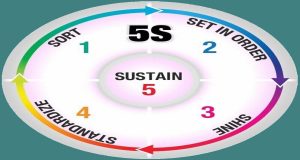We have seen as a result of the historical links with British rule in India the foundations of corporate law and accounting, like most other legal and political foundations in India, have been influenced by the UK system. So, international Accounting Standards have been used as a benchmark in setting accounting and reporting standards.
We shall look here at the developments in Indian accounting over the last three years. And compare the existing standards with international benchmarks. And how Indian companies began to adopt various international standards, especially the US GAAP, UK GAAP and IAS (‘international GAAP’), incorporation to presenting accounts under Indian GAAP.
The analysis we made here relates to accounting in general, and does not address the accounting and reporting requirements in specialised industries such as banking, insurance, finance, and so on.
Companies listed on the stock exchange mandated to have their annual general meeting within six months of the year-end. Financial statements are filed with the registrar of companies and the Securities and Exchange Board of India. The SEBI also requires filing of quarterly unaudited financial results and interim results, accompanied by the auditors’ limited review report.
Indian GAAP primarily comprises of 18 accounting standards (AS) issued by the Institute of Chartered Accountants of India (ICAI). To support interpretation, the ICAI has also issued guidance notes and ‘expert opinions’ on specific queries raised by companies and accountants. Of the three, however, only the standards are mandatory in the application. Additionally, in the financial statements the Indian Companies Act 1956 and various other industry-specific statutes prescribe certain minimum disclosures. However, the companies listed on the stock exchanges also need to comply with a few other accounting rules such as preparing cash flow statements and accounting for stock-based compensation.
Main GAAP differences
The Indian GAAP reflects international GAAP in the key accounting principles such as: prudence, going concern, consistency, accruals, substance over form and materiality. While currently the most significant accounting differences are absence of consolidation and deferred tax accounting. Although, there are other differences relating to disclosures such as: disclosure, segment reporting of related party transactions, and so on. However, with the introduction of new standards all these differences are most likely to disappear soon.

The recent transformations
Over the last three years the ICAI has initiated many changes. So, more significantly, have the companies themselves. For example, some large companies began to report their results of operations and financial position in accordance with international GAAP. Incoordination to presenting the mandatory Indian GAAP financial statements. Also, there are several reasons for this transformation.
In the beginning of 1990, the Indian government-initiated deregulation of the economy of India. With this step many foreign investors were attracted into India. Top companies such as: Unilever, Hyundai, Coca-Cola, McDonalds, Ford, DaimlerChrysler, ABN-Amro, Merrill Lynch, Goldman Sachs, Enron and Nokia, etc. To name just a few India as a key strategic area of operation.
Therefore, look at Multinationals not only invest in India directly but also enter into joint ventures or take significant stakes in long-established Indian companies. Examples include Ford Credit Kotak Mahindra, Prudential ICICI, Birla 3M, and so on. To smooth consolidate on with the parent company’s financial statements or to facilitate understanding of the results of the Indian joint ventures. Thus, in the respective home territories such as: the US, the UK and Germany, Indian companies affiliated to such multinationals resultant adopt international GAAP.
Adoption of GAAP
What led Indian companies to prepare accounts in compliance with international GAAP, especially US GAAP was the temptation of foreign capital markets. Also, companies with intentions to raise money on the US public markets, or merely have their shares traded. Therefore, need to prepare their accounts under US GAAP. However, the rules for a private placement in the US, do not require such a conversion.
While companies with intentions to go to the UK and Luxembourg markets either convert their accounts into IAS, reconcile from Indian GAAP to IAS or merely explain the key GAAP differences. Therefore, the variety of international capital market requirements has made it a necessity for Indian companies to present consolidated accounts. Thus, a new concept to the Indian reporting environment – and adopt other international GAAP requirements.
Moreover, the Indian government has eased some foreign currency restrictions. Also, the decision to allow Indian companies to reinvest their foreign initial public offering (IPO) proceeds abroad has been the most significant. Resultant this has encouraged many Indian companies to invest in the US and Europe, inescapably leading to the adoption of US GAAP, UK GAAP and IAS.
The effects
“Resultant for all these reasons, many Indian companies now publish their financials under US GAAP. And also, the other international GAAP as an integral part of their annual report. Indian companies that have registered with the US SEC involves: Infosys Technologies, Satyam Infoway, VSNL, ICICI, ICICI Bank and Silver-line Technologies. While many other companies are expected to tap international capital markets in the years to come.”
If we see at present the US GAAP is the most preferred international GAAP among Indian companies. Also, this is more by necessity than because of a specific preference. Capital market money and investment opportunities are more ample in the US today than in all other markets put together. As the market access improves in Europe and elsewhere the future, however, could tell a different story and as IAS improves its influence as a globally acceptable body of standards.
Moving closer to global standards
Issues relating to better accounting and reporting are continuously being addressed by the ICAI. While a new standard, AS 16, Borrowing Costs, aligns Indian accounting with international GAAP. Also, it requires adoption of the avoidable cost concept in determining the amount of interest that can be capitalised.
Thus, there is this clear evidence that the ICAI is moving swiftly to bring Indian accounting on a par with the rest of the developed countries and make it more compliant to analysis by foreign investors and analysts.
Although Indian GAAP differs primarily in certain respects from international GAAP. Yet it is taking the key steps to move closer to global best practices.
The key differences
Although there are many GAAP differences. But those of most prominent ones are briefly explained below.

Accounting
Consolidation, equity accounting and business combinations. One of the most significant differences in GAAP is the absence of both consolidation and equity accounting in Indian GAAP. As the parent company’s holding in each subsidiary is required to be disclosed along with the separate accounts i.e. not consolidated of each subsidiary. While the inter-company transactions are not required to be eliminated. Only When the investee declares dividends, i.e. when the earnings are distributed rather than when the profits are earned, only then the investor recognises its share of the investee’s earnings. Also, Indian tax law, too, does not recognise the consolidated results. AS 14, Amalgamations governs the Accounting for acquisitions and mergers. Resultant which lays down conditions for pooling and acquisition accounting. However, when international GAAP is applied a business combination can lead to different results.
Deferred taxation.
Since no accounting standard is there on the subject, so deferred tax accounting is absent in India except in the accounts of a few multinationals. As, the companies only account for the tax provision based on the current tax law. Consequently, also there is no such requirement for companies to reconcile their effective and statutory tax rates in the financial statements.
Leased assets.
Leases that, in substance, qualify as capital leases are internationally required to be accounted from operating leases. So, Indian GAAP does not require this differentiation. Thus, capital leases continue to remain on the lessor’s balance sheet. Therefore, stay outside the lessee’s balance sheet.
Depreciation (AS 6 and Sch XIII of the Companies Act).
AS 6, Depreciation Accounting, requires allocation of depreciation over an asset’s useful life. A requirement similar to that under international GAAP, and by prescribing minimum rates of depreciation the Companies Act reinforces this.
Pre-operative expenditure (AS 10 and guidance note).
AS 10, Accounting for Fixed Assets, basically prescribes capitalisation of costs until an asset is ready for its ‘intended use’. Also, a term is used in international GAAP literature. During the construction period provides a guidance note on expenditure incurred practical guidance on the subject. And allows the capitalisation of expenditure during the ‘trial run’ phase of asset construction. However, the term ‘intended use’ can hold practical interpretation differences, between Indian GAAP and international GAAP.
Revaluation of assets (AS 10).
Like UK GAAP and IAS, the Indian GAAP also allows the revaluation of property, plant and equipment. While, US GAAP does not allow any revaluation.
Foreign currency transaction differences (AS 11).
AS 11, The capitalisation of exchange differences arising on repayment of liabilities incurred for the purpose of acquiring fixed assets even after the asset is put to use are required by the Accounting for the Effects of Changes in Foreign Exchange Rates. Since, the International GAAP does not allow such foreign currency transaction differences to be capitalised. Therefore, resultant significant foreign exchange differences that are expensed under international GAAP are capitalised under Indian GAAP.
Valuation of investments (AS 13).
AS 13, except for other than temporary declines in values, the Accounting for Investments, necessitates the current investments to be carried at the lower of cost. And fair value and long-term investments at cost. Also, the aggregate market values of quoted long-term investments are required only to be disclosed, not adjusted. Whereas international GAAP allows, while in some cases it requires, long-term investments to be marked to market.
Revenue recognition (AS 9).
AS 9, when significant risks and rewards of ownership are transferred and no significant uncertainty exists over collection. The Revenue Recognition, requires revenues to be recognised. Since, this requirement is similar to international GAAP. However, when companies prepare their accounts under US GAAP revenue recognition comes under particular scrutiny, because of its numerous rules for specific situations.
Stock-based compensation.
Although on this subject there is no accounting standard. Still the SEBI has issued the Employee Stock Option Scheme and Employee Stock Purchase Scheme Guideline, 1999. Which requires listed companies to recognise compensation costs by busing either the intrinsic value method or the fair value method. Although the guidelines are brief, still they tally broadly with the approaches specified in US GAAP and UK GAAP for fixed plans.
Research and development expenditure (AS 8).
AS 8, Accounting for Research and Development, requires the deferral of costs meeting certain criteria which are similar to the requirements under UK GAAP and IAS. However, if accounts are prepared under US GAAP a different picture could emerge. Which generally requires all research and development costs to be expensed as incurred.
Derivatives.
In Indian GAAP other than AS 11 currently there is no such standard on the derivatives or hedge accounting, which deals with foreign currency transactions. Prohibition of trading in India is the main reason for a lack of literature except in a few areas, including the current introduction of trading in index futures.
Disclosures
In Indian GAAP Disclosures are primarily driven by the requirements of the Indian Companies Act and accounting standards.
Related party disclosures.
on certain transactions with directors the Companies Act requires limited disclosures. A new standard is issued by the ICAI, AS 18, Related Party Disclosures, which comes into effect in respect of accounting periods. Thus, while this is currently an important disclosure difference still it is anticipated to be bridged soon in Indian GAAP financial statements.
Skills Required to become a GAAP Professional
- Primarilly the basic knowledge of Generally Accepted Accounting Principles (GAAP)
- Secondly, high level of proficiency in Microsoft Excel
- Next knowledge of Quickbooks
- Subsequently, experience with business intelligence software
- Then knowledge of tax preparation software
- Moreover, proficiency in preparing financial statements
- Also, data query/data management abilities
- In fine, independent research skills
Career Opportunities
- US Taxation
- Charted Acocuntant
- Accounting and Finance Manager
- Senior Manager Finance & Accounts
- Manager Assurance – BIG 4 – CA Qualified
- Urgent for KPO Assistant Manager – Financial Reporting
- Associate Director
Learning Resources
Here we have enlisted a few learning resources for you please take a look-
Tutorials
There are numerous learning portals offering digital classes for GAAP. You can get yourself enroll for the same. The only thing to keep in mind is to calculate how it’s going to help you in your journey to learn the GAAP Principles.
Certifications
If you lack enough time to attend even digital classes due to your tight schedule. Then worry not there is a life-saving option for you i.e. Certifications. There are man y certification bodies offering you the professional courses to help you learn in your free time and become a Certified GAAP Professional.
Practice papers
There are many free and paid practice papers available for you to solve and self evaluate your level of knowledge. You can search online for the most relevant and dependable practice tests. This will help you know and measure your skills before you appear for any official exam and thus score better.
Conclusion
As we have already discussed the differences Indian GAAP and US GAAP hold. Now its the time for the aspirants to buckle up and grab the required knowledge.
This, learn, practice and become a Certified GAAP Professional



